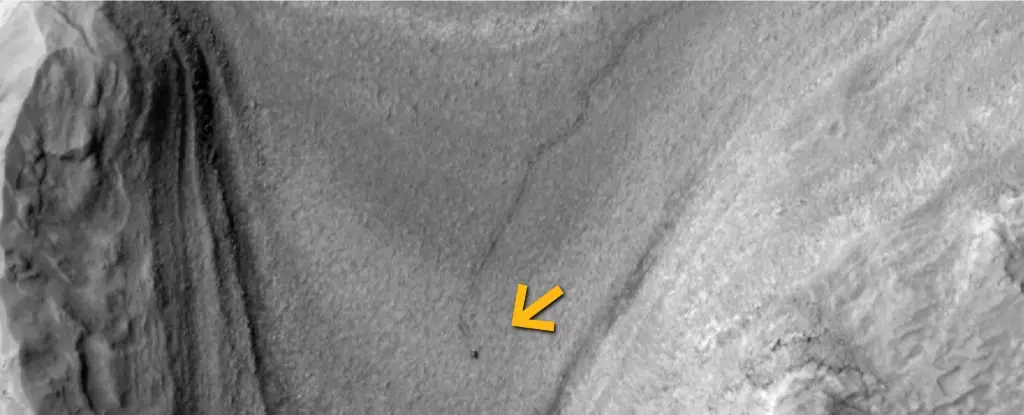Since August 2012, NASA’s Curiosity rover has been on a relentless quest across the rugged Martian landscape, dissecting the geological and hydrological history of an otherworldly planet. Despite being crafted in the name of science, Curiosity functions in an eerily solitary existence, isolated over 300 million miles from Earth. Each meticulous exploration and data collection adds to a monumental narrative of what Mars once was—and perhaps what it could become. Curiosity’s mission serves as a poignant reminder of human ingenuity, but it also raises the question: what does it mean to be alone in the vastness of space?
The recent image captured by NASA’s Mars Reconnaissance Orbiter illustrates this isolation vividly. From the orbiter’s vantage point, Curiosity appears as a tiny black dot, dwarfed by the expansive pale sands of Mars. This breathtaking photograph is more than a mere snapshot; it encapsulates the essence of Curiosity’s journey—a tribute to humanity’s longing to discover the unknown in the cosmos. Beyond merely documenting its presence, the image serves as a metaphor for the solitary pursuit of knowledge.
The Journey and the Challenge of Motion
In its remarkable journey, Curiosity has covered around 34.59 kilometers (nearly 22 miles), a modest distance considering the capabilities of human exploration. The rover’s top speed is a frustratingly slow 160 meters (about 525 feet) per hour—a mere fraction compared to an average human’s walking speed. However, this subdued pace is not a sign of inefficiency; rather, it is a calculated strategy. Curiosity’s slow mobility aids in preserving its limited power supply while allowing it to navigate the treacherous Martian terrain safely.
This careful navigation is essential in a world marked by unpredictable weather patterns and harsh conditions. Mars’ fierce winds can erase Curiosity’s tracks in moments, a stark reminder of the impermanence of its endeavors. The rover’s journey through the Gediz Vallis channel, believed to have been shaped by ancient floods, is a vivid illustration of the delicate balance of exploration and endurance. The landscape itself is a testament to forces long past, dictating how, where, and how fast Curiosity can maneuver.
Scientific Revelations and Geological Wonders
What Curiosity has unearthed during its travels is nothing short of extraordinary. While navigating the channel, it discovered a trove of pure sulfur—an enigmatic find that has scientists fervently examining its implications. As it ascended the small butte known as Devil’s Gate, Curiosity shifted its focus to geological formations such as Cahuilla and Santa Ynez, extending its scientific inquiry across the Martian surface.
The rover’s next target is even more intriguing: a series of boxwork formations at the base of Mount Sharp. These formations present a tantalizing possibility for researchers; if they adapt Earth’s geological principles, then the minerals held within may speak volumes about Mars’ wetter past and potential for ancient life. There’s an uncanny parallelism in the quiet geological processes that shape both Earth and Mars, inviting speculation about life’s potential in cold, alien environments.
Curiosity’s exploration of these fascinating structures raises vital questions regarding Mars’ climatic history. By investigating mineral deposits formed under conditions that were likely warmer and wetter, scientists can better understand whether microbial life ever existed on Mars. The search for signs of ancient life takes on a personal dimension through Curiosity’s eyes, provoking deep ethical and philosophical inquiries about humanity’s role in a universe that is, by nature, indifferent.
A Symbol of Human Spirit and Scientific Endeavor
Mars rovers like Curiosity are more than mechanical explorers; they embody the resilience and curiosity that define the human spirit. Presiding in their silent voyages across rugged terrains and harsh climates, they represent our eternal quest for understanding—a longing to connect with something greater than ourselves.
In the heart of the Gale Crater, under the expansive Martian sky, Curiosity stands as a monument to these ideals. As it continues its quiet but significant work, each wheel track left behind serves not only as a marker of navigation but as a reminder of the human spirit’s unyielding desire to explore, learn, and expand our horizons. The mission of Curiosity is not just about uncovering Martian mysteries; it is about the relentless pursuit of knowledge in the face of daunting odds, underscoring humanity’s indomitable quest for discovery among the stars.

